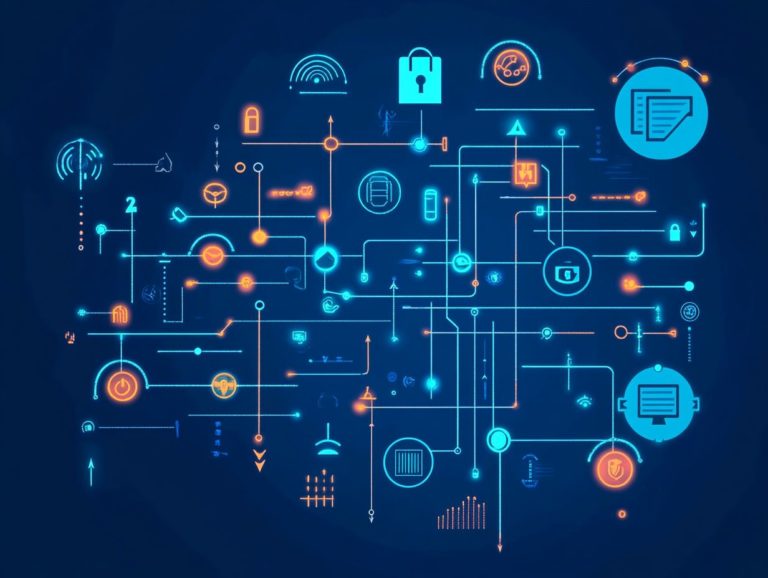the role of threat intelligence in incident response
In today s swiftly changing digital landscape, grasping the concept of threat intelligence is essential if you aim to bolster your incident response strategies.
This article delves into the definition and key components of threat intelligence and underscores its importance in enhancing both proactive and reactive measures during incidents.
You’ll explore various types of threat intelligence, from internal insights to external data, understanding how each plays a crucial role in early detection and effective mitigation.
We will outline best practices for integrating threat intelligence into your existing security framework, ensuring a strong defense against cyber threats.
Engage with us as we unravel the vital link between threat intelligence and successful incident response.
Contents
- Key Takeaways:
- Understanding Threat Intelligence
- The Importance of Threat Intelligence in Incident Response
- Types of Threat Intelligence
- How Threat Intelligence Supports Incident Response
- Implementing Threat Intelligence in Incident Response
- Frequently Asked Questions
- What is the role of threat intelligence in incident response?
- How does threat intelligence help in incident response?
- What types of threat intelligence are used in incident response?
- How can organizations incorporate threat intelligence into their incident response plan?
- What are the benefits of using threat intelligence in incident response?
- What are the challenges of using threat intelligence in incident response?
Key Takeaways:

- Effective threat intelligence is crucial for incident response, combining proactive and reactive measures to detect and prevent potential threats.
- Different types of threat intelligence include internal, external, strategic, and tactical, providing valuable insights for incident response.
- Integrating threat intelligence into existing security measures enhances incident response efforts through early detection, prevention, and effective mitigation.
Understanding Threat Intelligence
Threat intelligence helps protect against cyber threats. It involves gathering and analyzing data about potential vulnerabilities.
By using these insights, you can strengthen your security and stay ahead of cybercriminals.
Definition and Components
Threat intelligence is the gathering and analysis of data about cyber threats. This includes identifying signs that a cyber attack might be happening and understanding the methods used by cybercriminals.
These insights help you anticipate and effectively mitigate risks.
The importance of data analysis in this field is significant; it transforms raw data into actionable insights to fortify your defenses and respond to incidents swiftly.
The Importance of Threat Intelligence in Incident Response
Threat intelligence is critical for effective risk assessment and decision-making during incidents.
By harnessing real-time information, your incident management teams can respond swiftly to security incidents, mitigating potential damage.
In a landscape where cyber threats are continually evolving, actionable threat intelligence is vital for crafting robust response strategies, enhancing your organization s defenses against cybercriminals.
Enhancing Proactive and Reactive Measures
Enhancing proactive and reactive measures is essential for incident response, enabling you to prepare for and react swiftly to cybersecurity incidents.
A robust framework that integrates comprehensive security strategies can significantly minimize risks.
By leveraging automation tools, you can streamline the incident classification process for quicker threat identification.
Investing in well-defined recovery plans fosters resilience and positions your organization to recover with minimal disruption.
This dual approach allows your teams to be agile in their response, using real-time data to inform decisions and effectively reduce the impact of potential breaches.
Types of Threat Intelligence

Understanding the different types of threat intelligence is crucial for your organization. This knowledge includes both internal and external intelligence, which can be classified into strategic and tactical intelligence.
By grasping these distinctions, you position yourself to make informed decisions that strengthen your defenses against evolving threats.
Internal vs External Intelligence
Internal intelligence includes data collected from within your organization s systems. In contrast, external intelligence focuses on insights derived from outside sources that show the broader threat landscape.
Both types of intelligence are critical for developing a comprehensive understanding of security incidents. Internal intelligence provides a detailed look at your organization s vulnerabilities and historical threat data, enabling your teams to respond swiftly and effectively to breaches.
External intelligence offers valuable context, highlighting emerging global threats and trends that could impact your organization. Relying exclusively on one type can introduce complications. Internal data may lack the foresight that external sources provide, while external information can sometimes be overly generalized, leading to potential misinterpretations.
Striking a balance between both can significantly enhance your organization s security posture. This enables you to take proactive measures against potential attacks.
Strategic vs Tactical Intelligence
Strategic intelligence provides a high-level overview of threat actors and their motivations. Tactical intelligence dives into the specifics, offering detailed insights into specific threats and their operational details.
Understanding the distinction between these two forms of intelligence is vital for your organization’s success. It allows leaders to align overarching goals with immediate operational needs.
Strategic intelligence involves combining detailed information to assess long-term threats and opportunities. Meanwhile, tactical intelligence focuses on actionable insights that your teams can use in real-time, enabling them to effectively mitigate risk.
This synergy enhances your decision-making processes and cultivates a proactive approach to risk management. It ensures that your organization is well-equipped with both overarching trends and detailed data, allowing for responsive strategies that can adapt to evolving challenges.
How Threat Intelligence Supports Incident Response
Threat intelligence is essential for improving your incident response capabilities.
By facilitating early detection and prevention of potential cyber threats, you can implement effective mitigation strategies, safeguarding your organization against emerging risks.
Early Detection and Prevention
Early detection and prevention of threats are crucial in cybersecurity. They enable you to identify vulnerabilities and take proactive measures before incidents unfold.
By using a sophisticated array of tools and techniques, you can significantly enhance these proactive efforts. For instance, integrating advanced threat detection systems such as Intrusion Detection Systems (IDS), which monitor network activities for suspicious behavior, and Security Information and Event Management (SIEM) solutions, which analyze security alerts allows for continuous monitoring and real-time analysis of network traffic.
It’s essential to cultivate a culture of security awareness training among your employees. This equips them with the knowledge to recognize potential threats and respond effectively.
By combining these technologies with regular audits and updates, you not only strengthen your defenses but also foster a more resilient stance against the ever-evolving landscape of cyber threats.
Act now to safeguard your organization against potential threats. Implement these strategies to enhance your cybersecurity posture.
Effective Mitigation Strategies

Effective mitigation strategies are crucial in incident response. They help address threats and minimize the impact of security incidents.
These strategies prioritize proactive measures. Threat hunting identifies and counters vulnerabilities before they escalate.
By implementing well-defined security protocols, you can enhance your response time, ensuring that any suspicious activity is promptly investigated.
Incorporating real-time information about threats into your frameworks not only helps you understand emerging issues but also streamlines your decision-making process.
This comprehensive approach enables your teams to act decisively, leveraging critical data to refine their responses and bolster your overall cybersecurity posture.
Implementing Threat Intelligence in Incident Response
Implementing threat intelligence in your incident response strategy requires seamless integration with your existing security measures.
This approach fosters a more resilient cybersecurity framework, one that effectively counters cyber threats and improves your overall defenses.
Integrating with Existing Security Measures
Integrating threat intelligence with your existing security measures is essential for enhancing your capabilities in managing risks and responding to incidents.
Utilizing collaborative platforms cultivates an environment where threat data is shared and analyzed in real-time, allowing your teams to stay one step ahead of potential attacks.
This integration goes beyond just technology; it demands a cultural shift toward continuous security awareness among your staff.
Engaging employees with regular training and simulations fosters resilience against evolving threats, ensuring that everyone actively contributes to your organization s security posture.
In this dynamic landscape, collective intelligence becomes an invaluable asset in safeguarding sensitive information and minimizing the impact of breaches.
Best Practices for Utilizing Threat Intelligence
You must adopt best practices to stay ahead of threats! By integrating comprehensive data feeds into your security protocols, you can cultivate a more informed approach to identifying potential threats before they escalate.
- Employ effective risk assessment techniques to prioritize vulnerabilities, allowing your team to allocate resources efficiently.
- Engage in continuous monitoring and adapt your incident response strategies based on new intelligence.
Mixing proactive and reactive strategies not only strengthens your defenses but also ensures a swift response to emerging threats, ultimately safeguarding your sensitive information and maintaining operational integrity.
Frequently Asked Questions
What is the role of threat intelligence in incident response?

Threat intelligence gives organizations the information they need to spot and stop potential threats before they become incidents.
How does threat intelligence help in incident response?
Threat intelligence provides context and insight into potential security threats. It enables organizations to take proactive measures such as patching vulnerabilities, implementing security controls, and updating incident response plans to mitigate risks.
What types of threat intelligence are used in incident response?
Threat intelligence can be classified into three types: strategic, operational, and tactical. Strategic intelligence offers a broad overview of potential threats, operational intelligence focuses on current and emerging threats, and tactical intelligence provides real-time information on specific threats or attacks.
How can organizations incorporate threat intelligence into their incident response plan?
Organizations can bring threat intelligence into their incident response plan. They should regularly monitor threat data, assess risks, and connect this information with their security tools.
What are the benefits of using threat intelligence in incident response?
Using threat intelligence improves how quickly incidents are detected and responded to. It also enhances understanding of potential threats and aids in making better decisions during incidents, highlighting the role of threat intelligence in managed security services.
What are the challenges of using threat intelligence in incident response?
Challenges include needing skilled staff to interpret threat data and managing the complexity of this information. False positives and outdated info can also pose problems.






